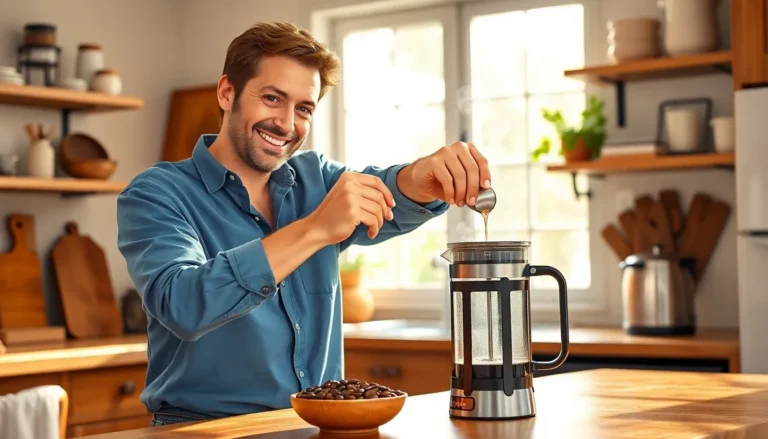Table of Contents
ToggleImagine waking up to the rich aroma of freshly brewed coffee wafting through your home. It’s like a warm hug for your senses, and who wouldn’t want that? Making the best coffee at home isn’t just a skill; it’s a delightful ritual that can turn even the grumpiest morning into a cheerful one.
Understanding Coffee Beans
Understanding coffee beans is essential for crafting the perfect cup at home. The type and quality of beans significantly influence flavor and aroma.
Types of Coffee Beans
Arabica and Robusta are the two primary types of coffee beans. Arabica beans, known for their smooth, nuanced flavors, account for about 60% to 70% of global coffee production. Robusta beans offer a stronger, bolder taste with higher caffeine content and make up roughly 30% to 40% of coffee production. Specialty beans, like Liberica and Excelsa, provide unique tastes but are less common. Each type contributes distinct qualities to coffee, impacting everything from sweetness to acidity.
Choosing Quality Beans
Choosing high-quality beans is crucial for an exceptional brew. Look for beans roasted within the last two weeks to ensure freshness. Seek origin labels that indicate Single Origin or Specialty Coffee to guarantee superior quality. Inspect the packaging for a roast date rather than a grind date; whole beans maintain flavor longer than pre-ground options. Consider your brewing method when selecting beans, as the grind size affects extraction and ultimately taste. Freshly ground coffee leaves a richer flavor profile, enhancing the overall brewing experience.
Essential Coffee Gear

Having the right coffee gear significantly impacts the brewing process and enhances the overall experience. Essential tools make it easier to create barista-quality coffee at home.
Coffee Makers
Coffee makers come in various types, each offering unique brewing methods. Drip coffee makers provide convenience and consistency, making them ideal for daily use. French presses deliver a rich, full-bodied cup by immersing coffee grounds in boiling water. Pour-over systems allow precise control over the brewing process, resulting in a clean and flavorful cup. Espresso machines, while more complex, offer the ability to craft rich, concentrated coffee shots. Assessing individual preferences and savoring different methods guide the choice of equipment.
Grinders
Grinders play a crucial role in determining flavor extraction. Burr grinders are preferred over blade grinders for their consistency and ability to produce uniform grounds. Ground size must match the brewing method; for instance, coarse grounds work well for French presses, whereas fine grounds suit espresso machines. Investing in a good grinder ensures freshness, as grinding coffee beans just before brewing maximizes flavor. The process contributes significantly to the final taste, so selecting the right grinder matters.
Brewing Techniques
Exploring brewing techniques unlocks the potential for a great coffee experience at home. Different methods cater to diverse tastes, each offering unique flavor profiles.
French Press Method
The French press delivers a rich and full-bodied coffee. Begin by coarsely grinding coffee beans; using a ratio of 1:15 coffee to water ensures optimal extraction. Add hot water to the grounds, typically at 200°F, and steep for four minutes. Press down the plunger slowly to separate the grounds from the brew. This technique retains oils and tiny particles, enhancing the coffee’s texture and taste. Pour directly into a mug and enjoy the robust flavor unique to this method.
Pour-Over Method
The pour-over method emphasizes control and precision. It begins with selecting medium-fine grounds for even extraction. Use a cone-shaped filter in a dripper placed over a carafe or cup. Heat water to about 200°F and slowly saturate the grounds in a circular motion. Allow the water to drain completely before pouring additional water in increments. This technique permits adjustments in brewing time and flow rate, adjusting taste strength as needed. Many find the clarity of flavor exceptional, making it a popular choice for coffee enthusiasts.
Water Quality and Temperature
Water quality and temperature play essential roles in brewing the best coffee at home. Utilizing clean water significantly affects the flavor.
Importance of Fresh Water
Fresh water enhances coffee’s taste. Contaminants and strong mineral flavors can spoil a brew, while fresh water brings out the coffee’s natural aromas. Tap water sometimes contains chlorine, which can alter flavors. Filtered or bottled water often provides a cleaner option. Many coffee enthusiasts prefer spring water, claiming it enhances overall quality. Strive to use water low in impurities to ensure a clean cup. Testing water hardness can also be beneficial, with a recommended level around 50 to 200 parts per million for optimal extraction.
Ideal Brewing Temperature
Brewing temperature influences extraction efficiency. Ideal brewing temperatures generally range from 195°F to 205°F. Lower temperatures can lead to under-extraction, producing sour and weak flavors. Conversely, higher temperatures often result in over-extraction, generating bitterness. Maintaining consistent temperatures throughout the brewing process enhances flavor profiles remarkably well. Coffee brewed at the right temperature reveals balance and complexity. Experimentation with temperatures within this range can help in discovering personal preferences for different coffee varieties.
Personalizing Your Brew
Personalizing coffee at home involves experimenting with various elements to discover unique flavors. Making adjustments can lead to cups that resonate with individual tastes.
Experimenting with Ratios
Finding the right coffee-to-water ratio significantly influences flavor. Standard recommendations suggest using one to two tablespoons of coffee per six ounces of water. However, altering this ratio allows for customization. Increasing coffee can enhance boldness while reducing it creates a lighter brew. Testing different ratios can lead to the perfect strength, providing a rewarding experience. Keep track of measurements to refine personal preferences consistently.
Adding Flavor Enhancements
Incorporating flavor enhancements opens up a world of possibilities. Consider adding spices such as cinnamon or nutmeg to the grounds before brewing, which adds warmth and depth. Flavored syrups can also introduce various fun taste profiles. Vanilla, caramel, or hazelnut syrups cater to diverse palates. Experimenting with milk options, like oat or almond milk, adds creaminess and unique flavors too. Trying different enhancements encourages creativity and keeps the coffee routine exciting.
Maintenance and Storage
Maintaining coffee equipment and storing beans properly enhances the coffee experience. Regular care prolongs the life of equipment and preserves the integrity of coffee flavors.
Cleaning Your Equipment
Cleaning coffee makers, grinders, and utensils prevents the buildup of oils and residues. A monthly deep clean with warm, soapy water removes stubborn stains and old coffee residues. Grinders benefit from a brush or cloth, while machines may require descaling to avoid mineral buildup. Rinsing carafes and pots after each use ensures freshness. Filters, if reusable, should be cleaned thoroughly to maintain flavor purity.
Proper Bean Storage
Storing coffee beans correctly preserves their freshness and flavor. An airtight container keeps beans away from air, light, and moisture. Room temperature is ideal; avoid storing beans in the refrigerator or freezer. Whole beans maintain flavor longer than ground coffee, so grind only as needed. Purchasing small quantities of freshly roasted beans ensures a rich flavor profile each time. Using a dark, cool cabinet helps protect beans from heat and light exposure.
Crafting the best coffee at home is an art that combines quality ingredients with personalized techniques. By selecting the right beans and equipment, anyone can elevate their morning ritual into a delightful experience. The journey doesn’t end with a single cup; it’s about exploring flavors and experimenting with different brewing methods.
Maintaining equipment and storing beans properly will ensure that every brew remains fresh and flavorful. With a little creativity and attention to detail, making coffee at home can transform into a satisfying and enjoyable process. Embrace the adventure of coffee-making and discover the joy of sipping a perfect cup tailored to individual tastes.







